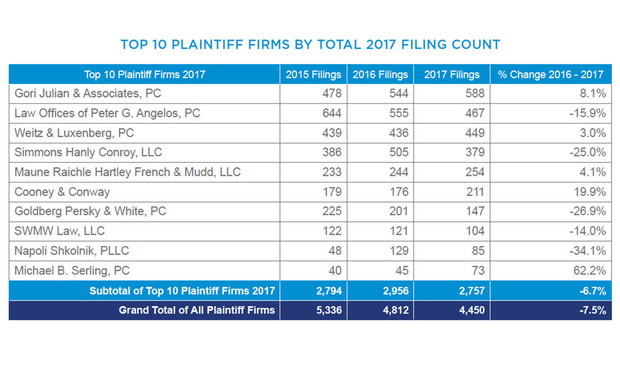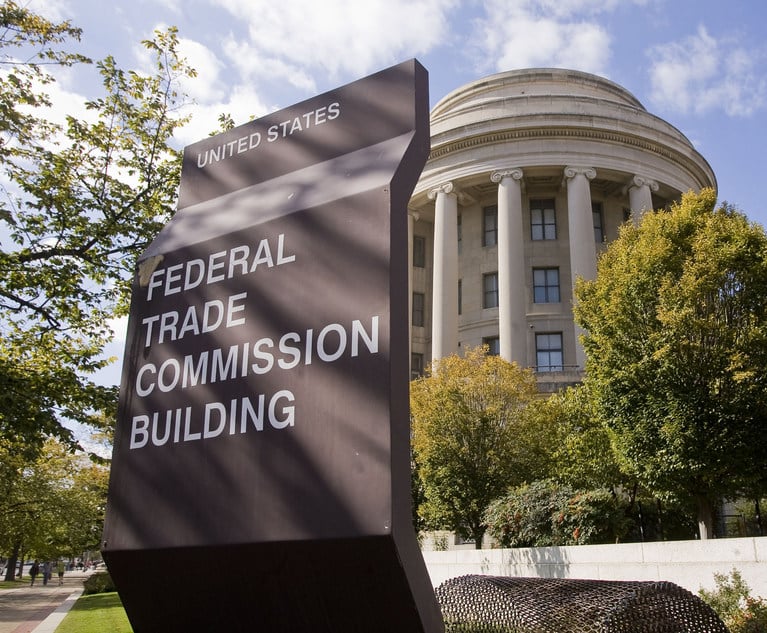Asbestos Filings Fell in 2017, Report Says
Asbestos filings fell in 2017, and it didn't matter whether they were brought over mesothelioma, lung cancer or other forms of cancer, according to consulting firm KCIC.
March 26, 2018 at 06:39 PM
5 minute read
The original version of this story was published on National Law Journal
 Asbestos chrysotile fibers that cause lung disease, COPD, lung cancer, mesothelioma. Photo Credit: shutterstock
Asbestos chrysotile fibers that cause lung disease, COPD, lung cancer, mesothelioma. Photo Credit: shutterstock Asbestos filings fell in 2017, and it didn't matter whether they were brought over mesothelioma, lung cancer or other forms of cancer, according to consulting firm KCIC.
The report, released this month, found that there were 4,450 asbestos filings last year, compared to 4,812 in 2016 and 5,336 in 2015, the first year that KCIC began compiling such data. For the first time, the decrease hit all types of cases. Mesothelioma cases were down 5 percent, lung cancer about 10 percent and other types of cancers nearly 12 percent.
KCIC, which consults defendant companies about products liability matters, including asbestos, gave no specific reasons for the decrease. But plaintiffs attorney Perry Weitz, co-founder of New York's Weitz & Luxenberg, who spoke about the report's findings at a conference this month, had a simple explanation: The number of victims was dwindling as fewer people work around asbestos.
“There's only a finite number of mesothelioma cases, and that number's going to go down every year anyway,” he said. And lung cancer cases, which have been harder for plaintiffs to blame on asbestos, are limited in number. “You'll see a certain leveling out. There's not going to be a dramatic decrease, and not a dramatic increase.”

The report found that the same top 10 plaintiffs' firms filed 62 percent of all asbestos cases. Those firms filed suits in predominantly the same venues against the same defendants for the most part, though the report speculated that the U.S. Supreme Court's June 19, 2017, decision in Bristol-Myers Squibb v. Superior Court of California could bring changes.
Topping the list of plaintiffs firms was Gori Julian & Associates, based in Edwardsville, Illinois, which filed 588 asbestos cases last year, up 8.1 percent from 2016. Three other firms increased their filings, including Weitz & Luxenberg, which filed 449 cases last year, but the rest of them reduced their output. The largest decreases came from Goldberg, Persky & White in Pittsburgh, which dropped 26.9 percent to 147 cases; Simmons Hanly Conroy, based in Alton, Illinois, which fell 25 percent to 379 filings; and New York's Napoli Shkolnik, which fell 34.1 percent to 85.
Shkolnik's Paul Napoli attributed his own firm's numbers to a singular focus on existing, rather than new, cases in 2017. But the general downward trend wasn't unexpected.
“Some of the major defendants have gone bankrupt in the last couple of years,” he said, noting the Chapter 11 filings of Kaiser Gypsum in 2016 and Georgia-Pacific in 2017. “These are big defendants that caused a lot of injury, so most of those claims have shifted to bankruptcy.”
The filings also remained concentrated in the same jurisdictions, although several had significant decreases. Madison County, Illinois, for instance, which has long held the No. 1 venue for asbestos filings, saw a 13 percent drop in 2017, while St. Clair County, Illinois, jumped 200 percent.
Napoli attributed that shift to recent defense verdicts that have come out of Madison County.
“It was no longer a haven for the plaintiffs to use against the defendants,” he said. “The defendants shot themselves in the foot by allowing plaintiffs to disperse the cases across the country, which makes it more expensive of them.”
Other top venues were New York, Philadelphia and New Castle County, Delaware. In particular, mesothelioma cases jumped 32 percent in Philadelphia, 25.5 percent in Middlesex, New Jersey, more than 21 percent in Alameda, California, and 5 percent in New Castle. They fell nearly 17 percent in New York and 16 percent in Los Angeles.
The report said recent U.S. Supreme Court decisions, like Bristol-Myers, could begin to impact where plaintiffs firms file their cases, with New York and Delaware potentially more favorable options given that more defendant companies have headquarters there. The report also noted that more plaintiffs firms, like Simmons Hanly Conroy, were filing cases outside of Illinois.
It also assessed the potential impact of legislation that required plaintiffs attorneys to disclose in court all claims that their clients made against bankruptcy trusts. The U.S. House of Representatives passed such legislation last year, but 13 states also have passed similar laws. In Ohio, the state with the most asbestos cases, filings have decreased at a greater pace since passing reform legislation in 2013, the report said.
Weitz said neither Bristol-Myers nor legislation over bankruptcy trusts had impacted asbestos filings.
“It has to do with the age of the litigation and the types of disease,” he said.
There are 3,000 mesothelioma cases across the nation, he said. “And that number goes down a little bit every year. And in the lung cancer cases, although there are more of them, plaintiff lawyers aren't in the habit of filing cases that aren't good cases that they won't be successful with.”
This content has been archived. It is available through our partners, LexisNexis® and Bloomberg Law.
To view this content, please continue to their sites.
Not a Lexis Subscriber?
Subscribe Now
Not a Bloomberg Law Subscriber?
Subscribe Now
NOT FOR REPRINT
© 2025 ALM Global, LLC, All Rights Reserved. Request academic re-use from www.copyright.com. All other uses, submit a request to [email protected]. For more information visit Asset & Logo Licensing.
You Might Like
View All
Private Equity Giant KKR Refiles SDNY Countersuit in DOJ Premerger Filing Row
3 minute read
'Strong' Legal Theory or 'Oxymoron'? Experts Eye FTC Antitrust Suit Against Mattress Merger
5 minute read

Trump Campaign's Defamation Suit Against Washington Post Is Tossed by Judge
Trending Stories
- 1ACC CLO Survey Waves Warning Flags for Boards
- 2States Accuse Trump of Thwarting Court's Funding Restoration Order
- 3Microsoft Becomes Latest Tech Company to Face Claims of Stealing Marketing Commissions From Influencers
- 4Coral Gables Attorney Busted for Stalking Lawyer
- 5Trump's DOJ Delays Releasing Jan. 6 FBI Agents List Under Consent Order
Who Got The Work
J. Brugh Lower of Gibbons has entered an appearance for industrial equipment supplier Devco Corporation in a pending trademark infringement lawsuit. The suit, accusing the defendant of selling knock-off Graco products, was filed Dec. 18 in New Jersey District Court by Rivkin Radler on behalf of Graco Inc. and Graco Minnesota. The case, assigned to U.S. District Judge Zahid N. Quraishi, is 3:24-cv-11294, Graco Inc. et al v. Devco Corporation.
Who Got The Work
Rebecca Maller-Stein and Kent A. Yalowitz of Arnold & Porter Kaye Scholer have entered their appearances for Hanaco Venture Capital and its executives, Lior Prosor and David Frankel, in a pending securities lawsuit. The action, filed on Dec. 24 in New York Southern District Court by Zell, Aron & Co. on behalf of Goldeneye Advisors, accuses the defendants of negligently and fraudulently managing the plaintiff's $1 million investment. The case, assigned to U.S. District Judge Vernon S. Broderick, is 1:24-cv-09918, Goldeneye Advisors, LLC v. Hanaco Venture Capital, Ltd. et al.
Who Got The Work
Attorneys from A&O Shearman has stepped in as defense counsel for Toronto-Dominion Bank and other defendants in a pending securities class action. The suit, filed Dec. 11 in New York Southern District Court by Bleichmar Fonti & Auld, accuses the defendants of concealing the bank's 'pervasive' deficiencies in regards to its compliance with the Bank Secrecy Act and the quality of its anti-money laundering controls. The case, assigned to U.S. District Judge Arun Subramanian, is 1:24-cv-09445, Gonzalez v. The Toronto-Dominion Bank et al.
Who Got The Work
Crown Castle International, a Pennsylvania company providing shared communications infrastructure, has turned to Luke D. Wolf of Gordon Rees Scully Mansukhani to fend off a pending breach-of-contract lawsuit. The court action, filed Nov. 25 in Michigan Eastern District Court by Hooper Hathaway PC on behalf of The Town Residences LLC, accuses Crown Castle of failing to transfer approximately $30,000 in utility payments from T-Mobile in breach of a roof-top lease and assignment agreement. The case, assigned to U.S. District Judge Susan K. Declercq, is 2:24-cv-13131, The Town Residences LLC v. T-Mobile US, Inc. et al.
Who Got The Work
Wilfred P. Coronato and Daniel M. Schwartz of McCarter & English have stepped in as defense counsel to Electrolux Home Products Inc. in a pending product liability lawsuit. The court action, filed Nov. 26 in New York Eastern District Court by Poulos Lopiccolo PC and Nagel Rice LLP on behalf of David Stern, alleges that the defendant's refrigerators’ drawers and shelving repeatedly break and fall apart within months after purchase. The case, assigned to U.S. District Judge Joan M. Azrack, is 2:24-cv-08204, Stern v. Electrolux Home Products, Inc.
Featured Firms
Law Offices of Gary Martin Hays & Associates, P.C.
(470) 294-1674
Law Offices of Mark E. Salomone
(857) 444-6468
Smith & Hassler
(713) 739-1250






